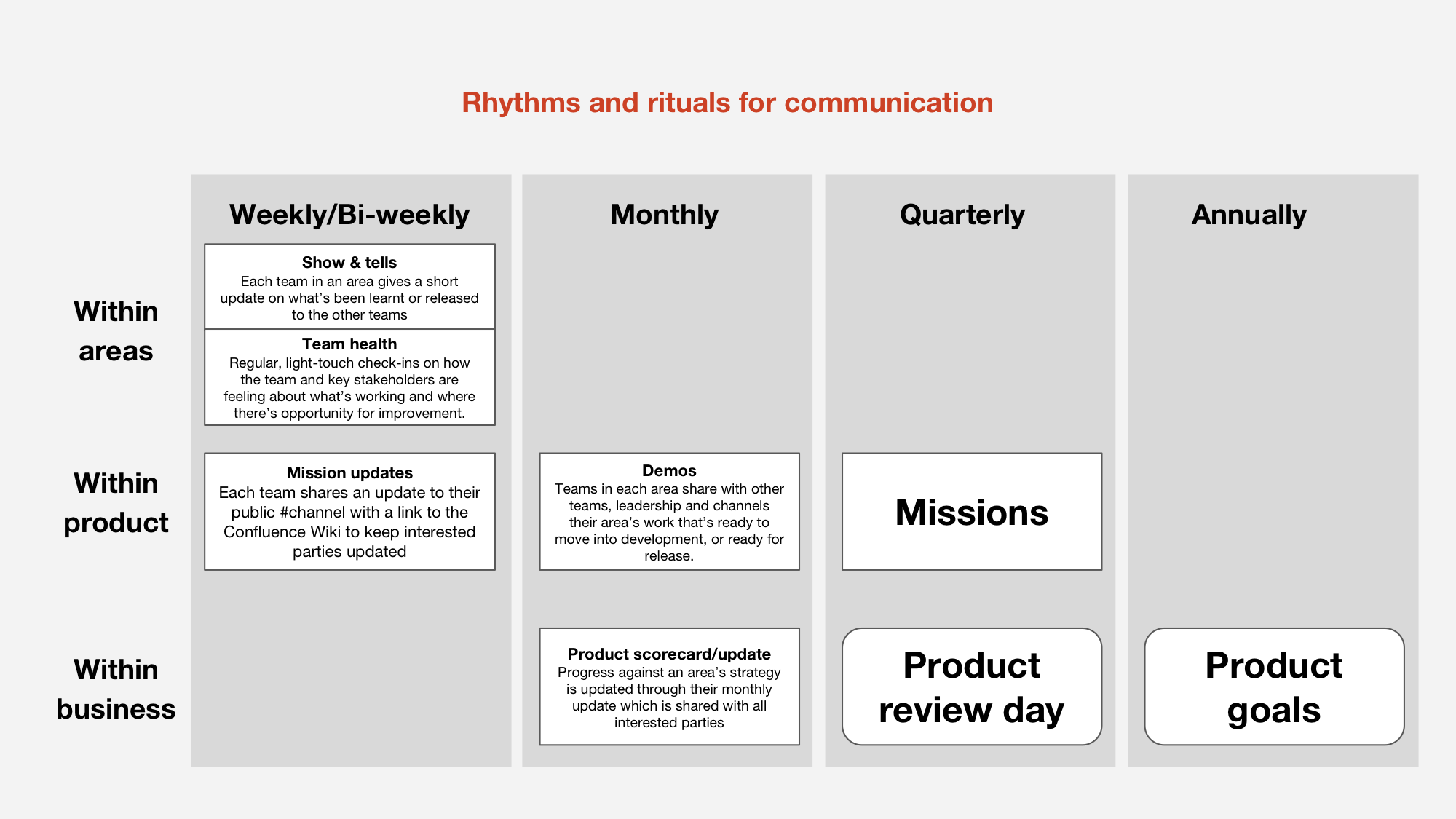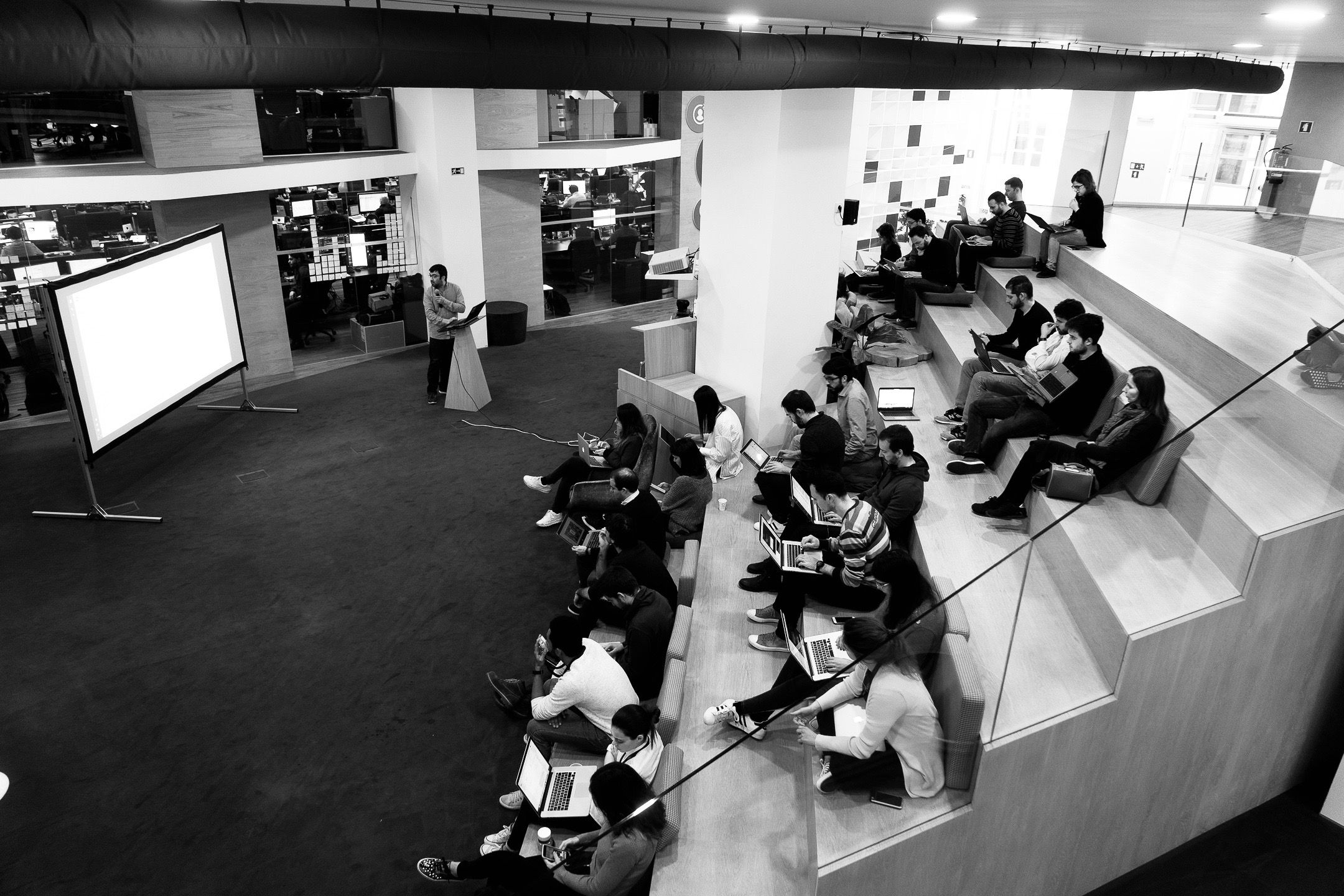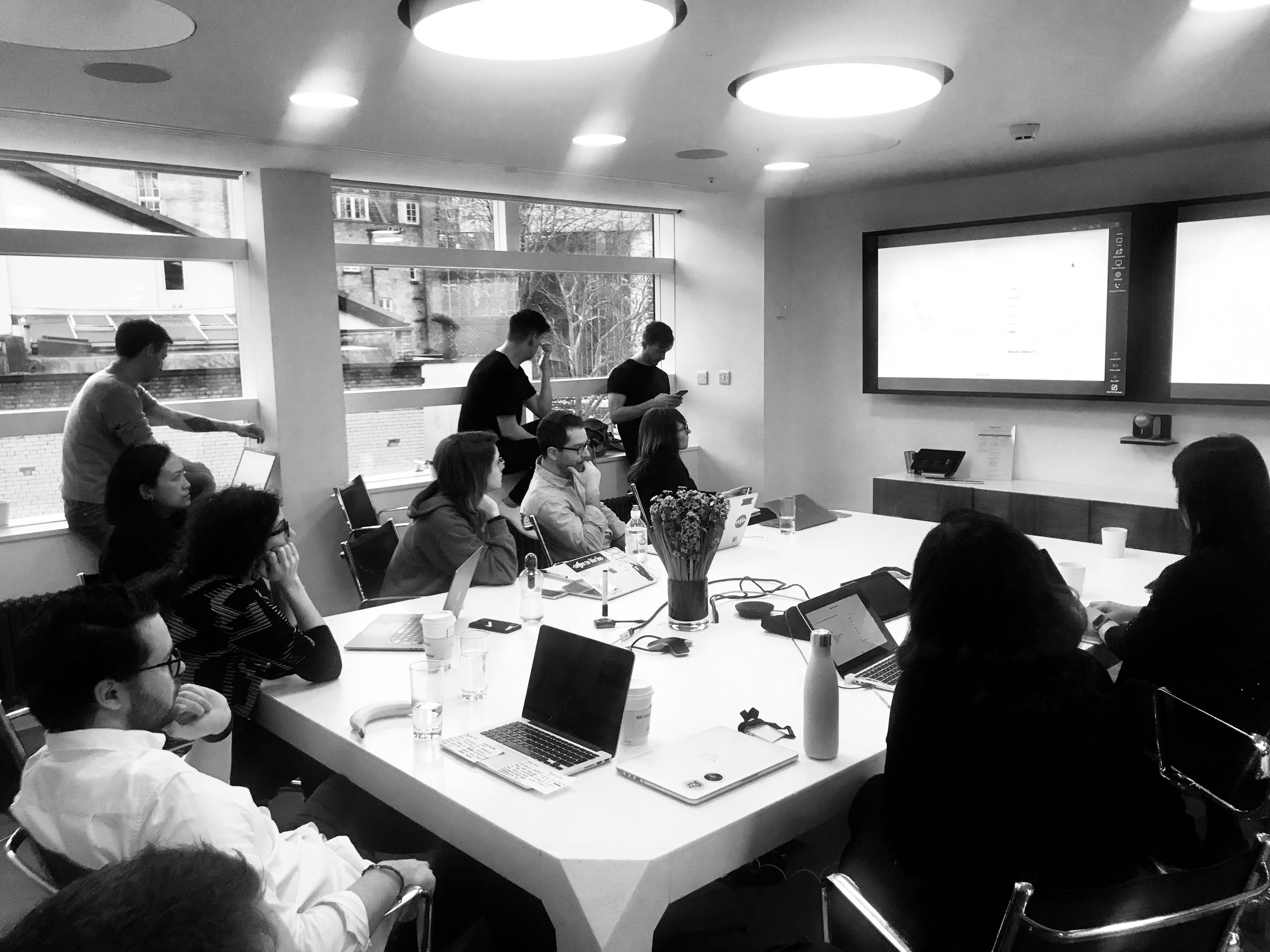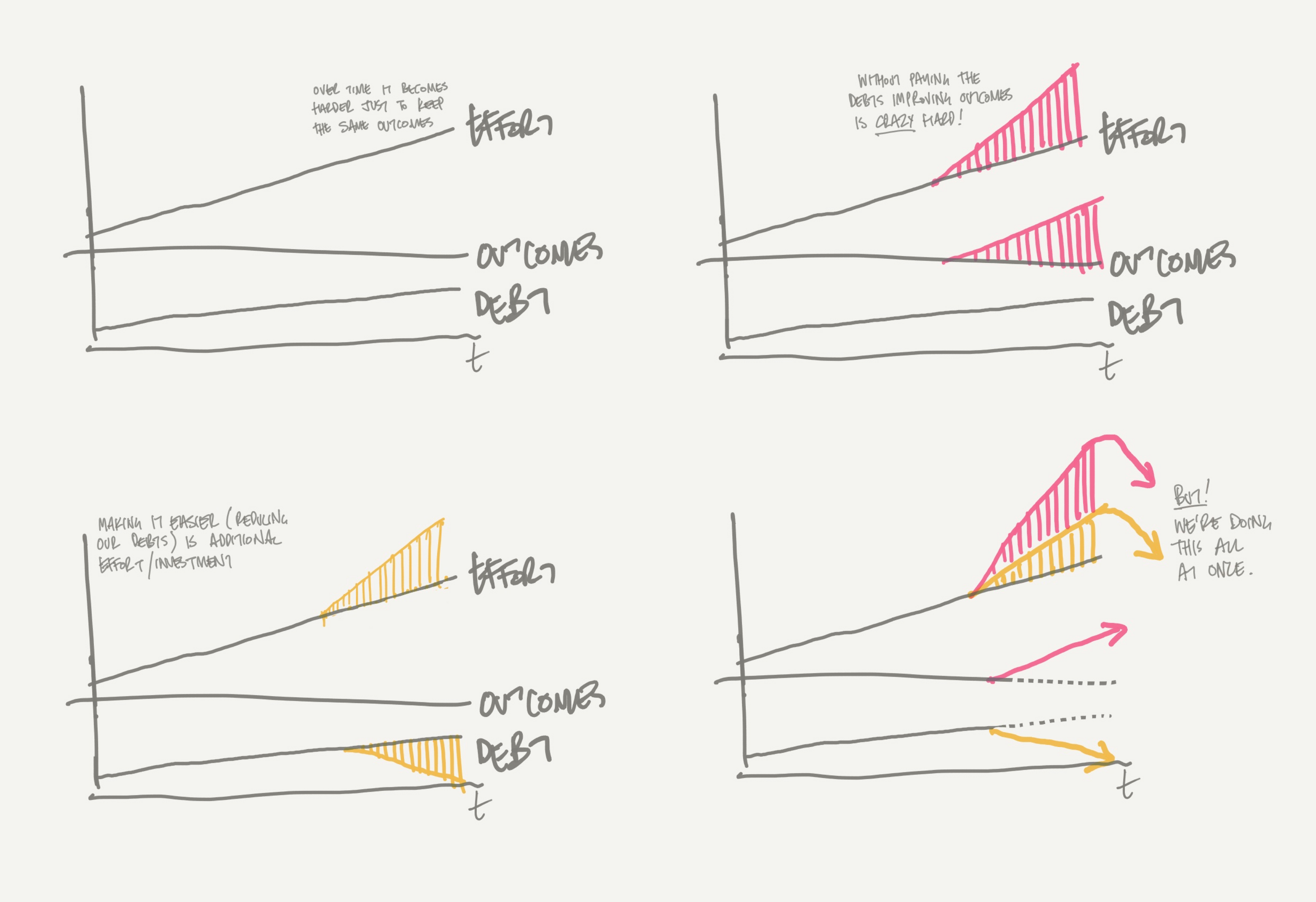February 22, 2019
Week 19 (18 went missing)
Last week was a lost one. Looking back at my todo list for the week it was lost to chasing too many small things and administration. I’ve a suspicion that these weeks are lost to my mood more than anything else, I definitely felt like I was struggling: progress was/is slow and feels a lot like hard work. I’m not finding my flow, and so I’m frowning a lot and finding myself feeling like I’m not doing the work I want to be doing. So it was good that I had some annual leave planned and took time out.
Coming back on Thursday to a short week was also helpful, and meant that after the usual 1:1s I had only time to focus on a couple of big things: our career framework and the show and tell.
Show and tell took its feedback from last time and had its second iteration today - key improvements were shortened timings (5 minutes per presenter), clear intro slides for each presenter so that people knew who to follow-up with and what they were talking about, and a much tighter control over the technology and handoffs between participating cities (this iteration saw people from Shanghai, Lisbon, London and Porto). It was amazing to see the work and more importantly to see different faces from the teams talking about their work.
The career framework is something that we need to sort out. I run a bi-annual survey on the team (based on the one in the book First, Break All the Rules). What we saw in that was an decrease in people knowing what was expected of them at work (pre re-org we had 20% of the team strongly agreeing with the statement, ‘I know what is expected of me at work’ which has dropped to 3%).
Given that we’ve changed some of our roles and moved away from a studio model to a different kind of organisational structure where the focus is on the knowledge and skills held in teams, I don’t think that’s surprising, but it’s on us to create some clarity here. I worry that the move away from designers progressing up to be either design managers or individual contributors has created uncertainty because we’ve changed the roles that people were looked towards when they were hired.
What we need to do is fill that uncertainty with something that people can interrogate and explore for themselves and then to use that critique to build a better framework.
progression
team
survey
low
show & tell
February 8, 2019
Week 17
Pay-offs
We’re beginning to see some of the rituals that we set out start to happen across the teams. One of the most important ones that we identified in our framework was the need for all our Area teams (ie. the teams of teams) to be able to see the work of other teams around Product. It matters for all the obvious reasons, but also because we need to do something about the belief that many of us held, which is that may of us simply have no idea about how the work of our teams is reaching our customers - we need better visibility.

This week Kuldeep, Anu and Tai’s work in making Show & Tells happen paid off. Everyone in Product spent Friday morning seeing the work in progress of over a dozen teams from around Europe.
It was fucking glorious.
 The auditorium in Porto
The auditorium in Porto  One of the meeting rooms in London
One of the meeting rooms in London
One of the messages that I’ve been banging on about diligently repeating is that show and tells will not be designers showing designs to designers. I’m really pleased to see that we had designers, product managers, researchers, software architects and data scientists all sharing the work of their teams.
Unseen labour
In the previous week I spent some time with everyone in my part of the org; it was long overdue and a good chance to start the year off by reminding us what we were trying to achieve with all the change we’re in and why we were doing it.
When we decided to change the way that Product was working, we did this in recognition of some information which was coming to us very clearly from our teams and the wider org: Product wasn’t working. We were seeing this in the frustration of our stakeholders (‘you’re a black box, we don’t understand what’s going on’) and from our teams (‘our work is unconnected with our customers and their lives’). We’re changing that, but change takes time, effort and persistence. We also need to acknowledge that in any change process there are gains and losses for the people involved.
Something that has been weighing on my mind a lot recently is that I’m asking the designers in Farfetch’s Product teams to help me carry the changes through, to be the ones who are helping the teams they’re working in to think and act in new ways.
And this is hard, often unseen work.
One of the things that I felt I needed to share with the team was that I too found this work hard, and if I’m honest, often unrewarding. Being the person in a team or a group who is facing the resistance or impassivity is emotionally draining. As an example, I had asked my leads to help their teams co-create Team Canvases, but when you’re the person asking the rest of the group to honestly look at the status quo and discuss those unstated expectations or implied roles we have for each other but nobody else sees value in doing so, that’s hard, hard work.
I belive that there are good explanations why we as designers in teams are the ones that carry that work, I think that we have to be honest that we have more to gain than lose by changing the current power structures in teams, that by using our skills and expertise to become more essential within the team we will have greater influence and control over the experience we’re creating for our customers.
If you believe in the gains/losses model here, then we have to accept that our pushing to disturb the current equilibrium means that others in our teams will feel loss. I asked our designers to think about how the people they work with may be experiencing the changes we’re making, and to be kind and patient with people – but that doesn’t mean I’m asking them to accept poor behaviour in others.
What I can do with my role is make sure that the message is restated and reinforced by our leadership teams: using our position in the hierarchy to exemplify, express and model the behaviour and values we expect to see in others. By doing this I hope that I make that unseen, often unacknowledged work of designers easier.
teams
work
unseen work
show & tell
rituals
practice
February 1, 2019
Week 16
The work starts
After what seems like a very, very long time the big wheel of work is slowly starting to turn, and we’re shifting our attention away from foundational things like organisation, process, vision and beginning to focus on the work of teams and how they move.
With so many teams (around 25) involved, that move is starting to make visible some of the tensions and underlying beliefs within people and teams, and we’re seeing what happens as you move from theory to practice. The positive take is that we have a huge opportunity to play and explore different ways to help make teams work together happily, anticipating this was one of the reasons I established a Practice team within my part of the Product function. The intent for this small team is that they create a sort of connective tissue between those small, autonomous teams and provide a mechanism for us to identify, catalyse and amplify ways to make our practice as designers stronger.
Working together, but not together.
This week, the Practice team started looking into the challenge of team cohesion and shared understanding which is a bit of a hot topic right now. Some of the designers in teams are feeling that others in or close to their team are hanging on to behaviours that we’re seeking to change: product managers as mini-CEO, PMs shuttling work orders between design and build, big design up front, high fences between design and engineering etc. It’s not all the teams, but enough to give a signal that we’re still aligning around practices in some places.
That alignment is exacerbated by the global nature of our teams; we have teams made up of designers and product managers in London, Porto, Lisbon and Shanghai, engineering teams in Porto, Lisbon and Shanghai. We then have our Area leadership teams (Heads of Engineering, Product and Design Principals who are responsible for teams of teams) made up of people in often different cities. During the reorganisation of the teams we sought to make sure that we kept teams as located within cities where possible, but that wasn’t always possible: London, for example has no Engineers. So we have a situation where these things can and do happen:
- Teams where the engineers are in different cities to the designers and product managers
- An Area’s leadership team based almost entirely in one city, but with one of them in another
What we want is teams working together on the same problems at the same time, so the first configuration is a real challenge to that: we see designers huddling together and working through things and then presenting it to the engineers in the team, and then negotiating the terms of a hand off.
The second configuration is leading to the individual in the Area’s leadership team feeling out of the loop - not close enough to the teams, not close enough to their peers in the leadership team.
Experiments and play
The current idea is that by helping those teams feel more connected to the people they’re working with by finding ways to enable those light, passive and peripheral interactions which happen when you’re in the same physical space. We believe that by creating opportunities for ad-hoc, unplanned interactions we’ll increase team cohesion and deeper context awareness around the work.
We’ve spent some time talking to and looking at other teams that have a similar challenge around multidisciplinary teams around the world. Here’s a teaser of some of the ideas that we’re looking to play with in the next few weeks.
- You and your team alway have headphones on and you’re dialled into a conference throughout the day. Make it super easy for people to pick up on conversations, but also to make it as easy to ask someone something as it would be if they were on the desk over from you.
- You and your team open Skype/Zoom/whatever for video and just leave it running.
- Figma and RealTimeBoard instead of team walls, try and have as much of the team’s work happen in here as possible
- The team create an agreement to only have discussion in a shared space - this came to us from another organisation, they said they needed to be incredibly diligent about policing this, calling out people who started a post-meeting side conversation for example. They said it was worthwhile though.
- Being more mindful about when to switch channels. Knowing when to stop it being a Slack chat and cutting over to a call. Text chat is great, but it’s fucking lousy at nuance, emotion or speed.
Communication
teams
work
co-location
practice
January 25, 2019
Week 15
Workshop with NOBL
Initially this was set up to help our leadership team form as humans, get to know one another and so on. When we were setting up the event, one of the things we talked about with Bud and Lauren was the need to model the type of teams we want our teams to be, which led to some interesting discussion about fractals and teams.
Anyway, the thing went well and reminded me about the importance of events like that (we’ve already set up one for my leadership team). The value of things like making time and space away from the routine is something I forget. There’s a comfort to the gentle inertia of the day in day out which I can see in my behaviour - things like nudging things forward across a wide front, rather than picking a few things and making them do or die.
The other thing I took away was a much better understanding of the people I work with and their motivations: it’s one of those things I knew was important to me, but had never reflected on. The realisation for me was that I think I tend to build relationships quite slowly (introvert…) and need, for my own reassurance, to know how that person ticks because I need the confidence of believing that they trust me.
What I took away
Some very steal-able group-working techniques, one was about getting to understand who you’re working with by creating a sort of user manual - seen these before but the way it was facilitated was great: we paired off and using a set of predefined questions, interviewed each other. Lots of fun, high-energy and a good way to form those early bonds.
The other was helping teams form a sense of their priorities without being railroaded by the HiPPOs. Built on a 2x2 (yay!) with impact/effort axes and using our leadership team backlog as an example. The team forms a conga line, and each person sequentially gets to move items from the backlog onto the 2x2, or move items on the 2x2 into another quadrant. The fun part was that you only get a minute, and 2 passes of the conga line.
offsite
team
exercises
trust
January 18, 2019
Week 14
Not a lot happening first half of the week - frozen shoulders knocked me out over the weekend and that spilled through to working week. One cause of this is sitting in too many planes last week (London to Porto, Porto to Lisbon and Lisbon back to London). Lanky people like me aren’t a great fit on budget airlines, so I end up bent out of shape. The other explanation is that I’m just run down - the last few months have been exceptionally hard for those of us who are trying to help change the way Product works here.
 Why we’re tired
Why we’re tired
We’ve been very busily trying to create some foundations for the Product function here, and we’ve been trying to do that without the whole house falling down. That takes a lot of carefully applied energy and resources, so that alone is draining. On top of that, we’re doing this in the context of significant changes to the business: we’ve IPO’d and that brings a new reality to bear on our practices (ie. external change forces added to the structural changes) - we’ve done that whilst keeping up our day-to-day responsibilities of driving and developing a global marketplace for our customers. How we move out of this moment and shift our focus back to work and the work of our teams was a big topic in my end of year review, and it’s good to have a boss who shares this understanding, I’m not sure the situation would be tenable otherwise. While it’s hard to voice that I feel tired and utterly divorced from the sources of my energy and drive (making things better for our customers) it’s incredibly helpful to be able to straight talk with someone I trust.
The week ended on a high though. Alex in my team has been busy collaborating with the Engineers to create a native UI framework (initially for iOS) that will extend the work of the Design System team and create a set of shared code/design artefacts that allow anyone to very quickly piece together a UI from common components using simple markup. I took the chance to showcase the work with my boss, and it ended up with her, the CTO and the Director of Engineering in attendance (because big-org culture…). The work they’ve done is just fantastic and shows what the creation of scalable, modular UI can do. Seeing designers and engineers working together on the same things, at the same time using the same tools is where we want to be.
It was fucking brilliant.
change
transformation
fatigue
UI
design systems
January 11, 2019
Week 13
Lots of missing weeks, blame holidays, illness and me getting pissed off
Started the week in Porto, then over to Lisbon and finally back to London.
The plan was to run end of year reviews with some of my design leaders. I’m moving their reporting lines to mine: partly to ensure their current manager has clear focus as he starts to establish Farfetch’s design practice team, but mostly because I want to ensure we’re giving these particular folks room to grow and develop in their own right.
I’m a little worried as the previous manager is phenomenally good and has a very different approach, so one of the things I wanted to do was to start things off with a very open ended, exploratory conversation to help me understand them, and to give them a chance to help understand where I’m coming from. It turned out that the previous manager couldn’t make it, so I decided to leave the retrospective with him (I’ll participate) and use the time to have a more forward-thinking discussion.
What we did.
Open ended discussion focussing on what might we want to amplify or make stronger within their current practice, with me taking notes (allowing them to think more freely and me to capture thoughts).
My notes included:
- topics and themes which came up
- comments that I found interesting and wanted to explore more but didn’t want to disrupt flow
- opportunities I saw for actions and development
I committed to writing up my understanding of the discussion, and asked them to reflect on the discussion afterwards and write down their thoughts.
At this stage, the outcome we’re looking for is a clear understanding of what their ambitions are for their professional growth, this means thinking years ahead and thinking beyond the existing business organisation and structures. I want to make sure people are thinking about their working life, and not just their working life at Farfetch. In later discussion we’ll pull this timeline back a little and start thinking about the next year or so and what actions we can take to move towards their ambitions. To that end, I’ve asked them to do a little homework…
Homework 1: write your end of year review for the year 2021
- What were your proudest achievements?
- What did you do that pushed you outside your comfort zone?
- What would you like to do in the year ahead?
This seeks to take a standard bit of organisational furniture and to refigure it to provoke some thoughts about the sort of work and practices that someone could be doing in their future. The intent is to uncover some hints of the sorts of things that will make people proud, where they see some stubborn/longstanding obstacles to their growth and also gives them space to distance themselves from the work they’re doing today and talk freely. I’ve often found that people tend to extrapolate out from their current role, so asking people to go a few years ahead means that becomes less likely.
Homework 2: write your leaving card for 2021
- What did the people around you say to you when you left?
- How did you make people feel?
My friend Ken Yau gave me a quote that I come back to often:
“People will forget what you said, people will forget what you did, but people will never forget how you made them feel” Maya Angelou
I like this because it reminds me about the very human side of leadership and that feelings and emotions are a very important part of our professional lives. This second piece of homework is set up to help people think about their work in these terms. The intent in this homework is to ensure that we’re thinking about growth in terms of all the skills we need - not just the more obvious ‘technical’ ones.
team
people
leadership
techniques



